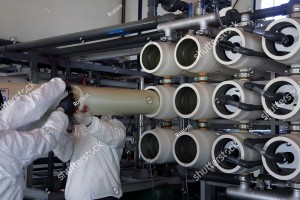Reverse osmosis (RO) membranes are a critical component in water purification systems, renowned for their ability to remove a wide range of contaminants, including salts. The RO Membrane salt rejection rate is a vital parameter that determines the effectiveness of an RO membrane in producing high-quality, purified water. In this article, we will explore what the salt rejection rate is, how it works, and its significance in various applications.

What is Salt Rejection Rate?
The salt rejection rate refers to the percentage of dissolved salts that a reverse osmosis membrane can remove from a solution. This rate is typically expressed as a percentage, calculated using the following formula:
Salt Rejection Rate(%)=(Cf−CpCf)×100\text{Salt Rejection Rate} (\%) = \left( \frac{C_f - C_p}{C_f} \right) \times 100Salt Rejection Rate(%)=(CfCf−Cp)×100
Where:
- CfC_fCf = Concentration of salts in the feed water
- CpC_pCp = Concentration of salts in the permeate (the purified water)
For example, if the feed water has a salt concentration of 1,000 mg/L and the permeate has a concentration of 10 mg/L, the salt rejection rate would be:
Salt Rejection Rate=(1000−101000)×100=99%\text{Salt Rejection Rate} = \left( \frac{1000 - 10}{1000} \right) \times 100 = 99\%Salt Rejection Rate=(10001000−10)×100=99%
How Do RO Membranes Achieve High Salt Rejection?
RO membranes are designed with a semi-permeable structure that allows water molecules to pass through while rejecting larger molecules, including dissolved salts. The effectiveness of this process is influenced by several factors:
-
Membrane Material: Most RO membranes are made from polyamide or polyethersulfone, which exhibit excellent salt rejection properties.
-
RO Membrane Thickness: Thicker membranes generally offer higher salt rejection rates, but they may also slow down permeate flow.
-
Operating Pressure: Higher pressure increases the driving force that pushes water through the membrane, enhancing the separation process.
-
Feed Water Quality: The presence of certain ions or contaminants can affect the performance of the membrane, potentially impacting the salt rejection rate.
-
Temperature: Higher temperatures can improve water permeability, but they may also affect the rejection characteristics of certain salts.
Importance of Salt Rejection Rate
The salt rejection rate is crucial for several reasons:
-
Water Quality: A high salt rejection rate ensures that the produced water meets the necessary quality standards for drinking, industrial processes, or irrigation.
-
System Efficiency: Membranes with high salt rejection rates reduce the total dissolved solids (TDS) in the permeate, leading to better overall system performance.
-
Cost-Effectiveness: Systems that achieve higher salt rejection rates often require less frequent maintenance and membrane replacement, resulting in lower operational costs.
-
Regulatory Compliance: Many industries are subject to regulations regarding water quality, making high salt rejection rates essential for compliance.
Applications of Reverse Osmosis Membranes
RO membranes with high salt rejection rates are used in various applications, including:
- Desalination: Converting seawater into freshwater for drinking and irrigation.
- Industrial Water Treatment: Purifying water for manufacturing processes.
- Food and Beverage Industry: Ensuring the safety and quality of water used in production.
- Pharmaceuticals: Meeting stringent purity standards for water used in drug manufacturing.
Conclusion
The salt rejection rate is a key performance indicator for reverse osmosis membranes, directly influencing the quality of purified water produced. Understanding how this rate is determined and the factors that affect it is essential for optimizing RO systems in various applications. By choosing high-quality membranes and maintaining optimal operating conditions, industries can achieve the desired salt rejection rates, ensuring efficient and effective water purification processes.





 Language
Language




 Network Supported
Network Supported